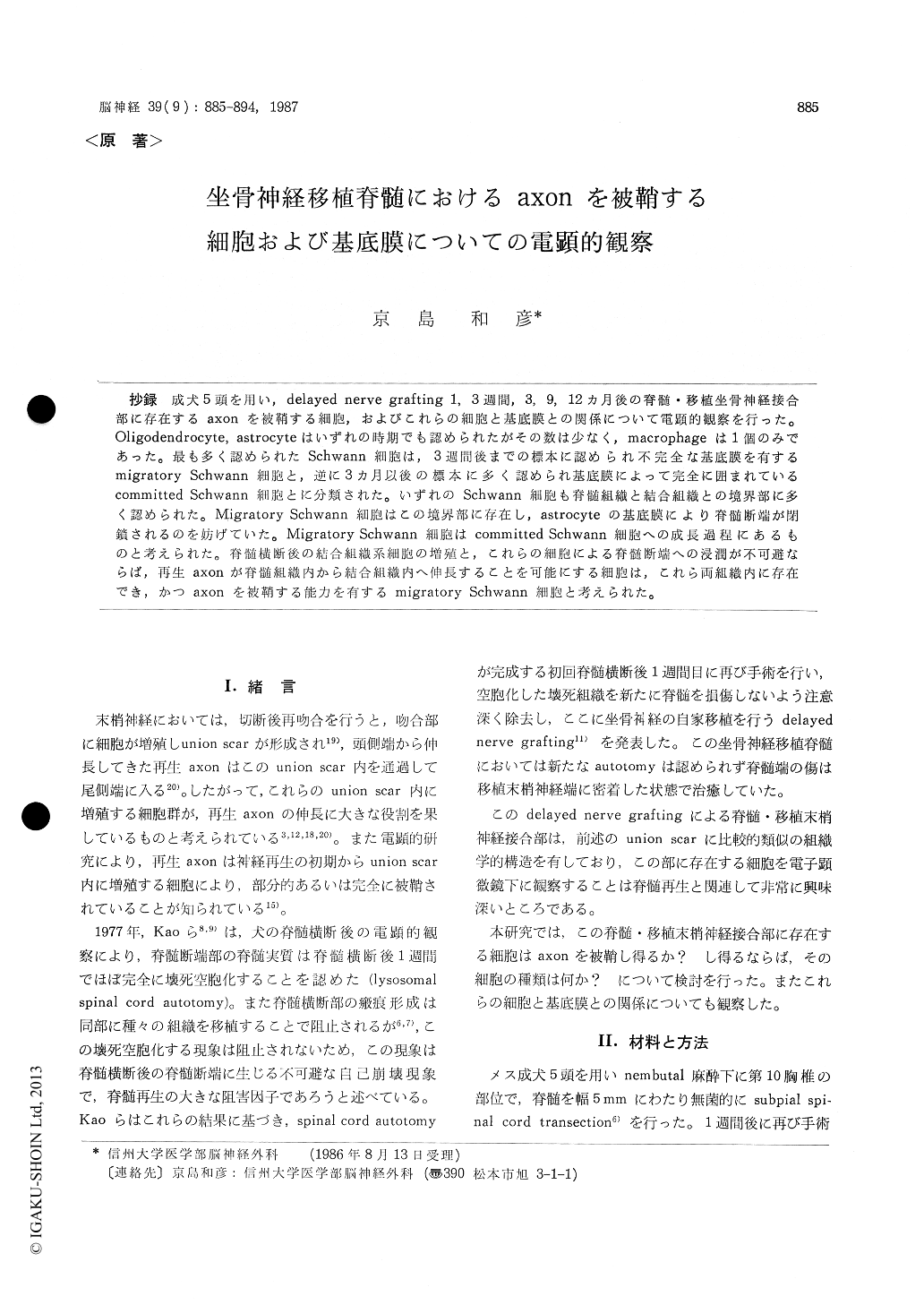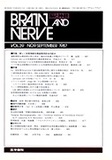Japanese
English
- 有料閲覧
- Abstract 文献概要
- 1ページ目 Look Inside
抄録 成犬5頭を用い,delayed nerve grafting 1, 3週間,3,9,12ヵ月後の脊髄・移植坐骨神経接合部に存在するaxonを被鞘する細胞,およびこれらの細胞と基底膜との関係について電顕的観察を行った。Oligodendrocyte, astrocyteはいずれの時期でも認められたがその数は少なく,macrophageは1個のみであった。最も多く認められたSchwann細胞は,3週間後までの標本に認められ不完全な基底膜を有するmigratory Schwann細胞と,逆に3ヵ月以後の標本に多く認められ基底膜によって完全に囲まれているcommitted Schwann細胞とに分類された。いずれのSchwann細胞も脊髄組織と結合組織との境界部に多く認められた。Migratory Schwann細胞はこの境界部に存在し,astrocyteの基底膜により脊髄断端が閉鎖されるのを妨げていた。Migratory Schwann細胞はcommitted Schwann細胞への成長過程にあるものと考えられた。脊髄横断後の結合組織系細胞の増殖と,これらの細胞による脊髄断端への浸潤が不可避ならば,再生axonが脊髄組織内から結合組織内へ伸長することを可能にする細胞は,これら両組織内に存在でき,かつaxonを被鞘する能力を有するmigratory Schwann細胞と考えられた。
In transected and reanastomosed peripheral nerve, cells proliferate in the scar which unites the proximal and distal cut ends of the nerve. Those cells are considered to produce favorable effects on the advancement of naked axons, and ultrastructural studies have revealed that the naked axons are partially or completely ensheathed by cells in the union scar. On the other hand, in a spinal cord model, structure with a histological appearance similar to that of the union scar in the transected peripheral nerve has been produced experimentally by delayed autogenous sciatic nerve grafting into the transected spinal cord gap. In the present study, the same spinal cord model was used and an electron microscopic study of the junctional area between the spinal cord and gra-fted nerve was carried out in an attempt to an-swer the following questions : ( 1) Do cells in the spinal cord-nerve graft junction ensheath axons ? And, if so, ( 2 ) is it possible to identify these cells?
Five adult dogs were used for the experiment. One week after the first spinal cord transection, the wound was opened, necrotic materials in the gap were carefully removed microsurgically, and segments of autogenous sciatic nerve were placed in the gap of the spinal cord. The dogs were killed at 1 and 3 weeks, 3, 9 and 12 months after the delayed nerve grafting and electron micro-scopic observations were made. The cells which en-sheathed axons at the graft junction were classified into five morphologically identifiable cell types : migratory Schwann cells, committed Schwann cells, astrocytes, oligodendrocytes and macrophages. Mig-ratory Schwann cells had the essential components of a mature Schwann cell except for the absence of, or only partial presence of, a basal lamina (neurilemmal basal lamina). These cells were found less than 3 weeks after the delayed nerve grafting and were frequently lodged at the stump of the glial basal lamina. in the 3- to 12-month speci-mens, no such cells were found. Committed Schwann cells, which are the usual mature Schwann cells and are completely encircled by the neuri-lemmal basal lamina, were mostly identified at 3 to 12 months after grafting. Astrocytes and oligo-dendrocytes also ensheathed axons but their acti-vities were much less significant. Only one macro-phage-ensheathed axon was observed.
From the present results it is supposed that the migratory Schwann cell serves as a gate in the glial basal lamina for possible passage of an axon through the cell, which is later converted to a committed Schwann cell ; the junctional node of Ranvier is formed at the plane of the glial basal lamina] stump. If the invasion by connective tissue elements is truely inevitable following spinal cord transection, then the only cell typo that could pos-sibly promote passage of axons form central ner-vous system territory into connective tissue ter-ritory, would be the migratory Schwann cell, because this cell is the only cell type that is axon-oriented and that can be present in both central nervous system and connective tissue territories.

Copyright © 1987, Igaku-Shoin Ltd. All rights reserved.


